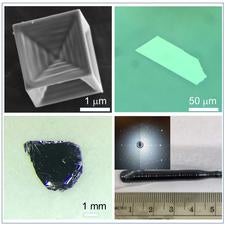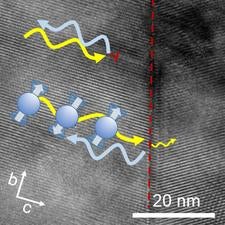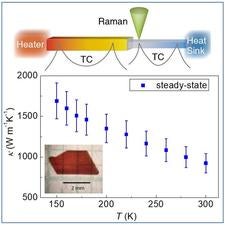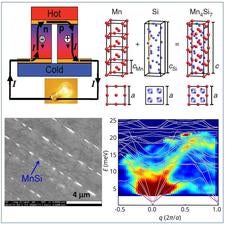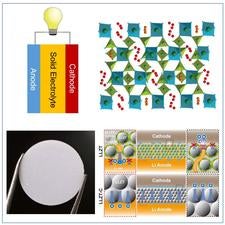Research Areas
Engineering of materials at quantum scales shows great potential to revolutionize energy and information technologies. Understanding the microscopic transport mechanisms and energy dispersion relationship of magnons, spinons, and phonons in these materials is crucial to develop high performance quantum devices for computation, sensing, and energy storage and conversion. Our group is interested in single crystal growth of quantum materials and investigating the quasiparticle transport in these materials.
-
Crystal growth of novel quantum materials
Quantum materials are broadly referred to as materials where extraordinary effects of quantum mechanics give rise to exotic and often unexpected properties. The potential technology bounty of quantum materials stems from the exotic quasiparticles they can harbor (magnons, spinons, skyrmions, etc.). In Chen group, we grow novel quantum materials using various techniques, including optical floating zone method, chemical vapor transport, flux growth method and wet chemical method.
Selected publications:
(1) X. Chen, T. J. Zhu and X. B. Zhao, “Synthesis and Growth Mechanism of Rough PbTe Polycrystalline Thermoelectric Nanorods,” J. Cryst. Growth, 311, 3179 (2009)
(2) K. An, K. S. Olsson, A. Weathers, S. Sullivan, X. Chen, X. Li, L. G. Marshall, X. Ma, N. Klimovich, J. S. Zhou, L. Shi, and X.Q. Li, “Magnons and Phonons Optically Driven out of Local Equilibrium in a Magnetic Insulator,” Phys. Rev. Lett., 117, 107202 (2016) -
Spin caloritronics
Spin caloritronics focuses on the interaction of electron spins with heat currents. The strong spin-spin exchange interaction in some low-dimensional magnetic materials can lead to a high group velocity and thermal conductivity contribution from spin excitations, such as mangons and spinons. We employ thermal transport measurements and inelastic neutron scattering to understand the transport length scales and coupling mechanisms of these spin excitations.
Selected publications:
(1) X. Chen, J. Carrete, S. Sullivan, A. Roekeghem, Z. Li, X. Li, J. Zhou, N. Mingo, and L. Shi, “Coupling of Spinons with Defects and Phonons in the Spin Chain Compound Ca2CuO3”, Phys. Rev. Lett., 122, 185901 (2019)(2) X. Chen, J. Kim, Q.R. Jia, S. E. Sullivan, Y.M. Xu, K. Jarvis, J.S. Zhou, and L. Shi, "Synthesis and Magnon Thermal Transport Properties of Spin Ladder Sr14Cu24O41 Microstructures," Adv. Funct. Mater., 202001637 (2020)
(3) S.C. Guo, H.Z. Li, X. Bai, Y.T. Wang, S.C. Li, R.E. Dunin-Borkowski, J.S. Zhou and X Chen, "Size-dependent magnon thermal transport in a nanostructured quantum magnet," Cell Rep. Phys. Sci., 5, 101879 (2024)
-
High thermal conductivity materials
Because of the shrinking size and increasing density of transistors, heat dissipation has become a critical challenge for microelectronic devices. Inefficient heat removal from localized hot spots in semiconductor devices compromises device performance and accelerates electromigration and thermomechanical failures. To address this challenge, novel high thermal conductivity materials, such as cubic boron arsenide, are being developed for thermal management applications.
Selected publications:
(1) F. Tian#, B. Song#, X. Chen#, N. Ravichandran, Y. Lv, K. Chen, S. Sullivan, J. Kim, Y. Zhou, T.H. Liu, M. Goni, Z. Ding, J. Sun, G. G. U. Gamage, H. Sun, H. Ziyaee, S. Huyan, L. Deng, J. Zhou, A. J. Schmidt, S. Chen, C.W. Chu, P. Y Huang, D. Broido, L. Shi, G. Chen, and Z.F. Ren, “Unusual High Thermal Conductivity in Boron Arsenide Bulk Crystals,” Science, 361, 582 (2018) [#contributed equally](2) X. Chen, C.H. Li, Y.M. Xu, A. Dolocan, G. Seward, A.V. Roekeghem, F. Tian, J. Xing, S.C. Guo, N. Ni, Z.F. Ren, J.S. Zhou, N. Mingo, D. Broido, and L. Shi, "Effects of Impurities on the Thermal and Electrical Transport Properties of Cubic Boron Arsenide," Chem. Mater., 33, 6974 (2021)
-
Thermoelectrics
Thermoelectric (TE) materials, which can convert temperature gradient directly into electricity and vice versa, have received renewed interest for waste heat recovery and refrigeration applications. We fabricate high-performance TE devices based on abundant silicides. Chemical doping and nanostructuring are used to improve the figure of merit ZT of these silicides.
Selected publications:
(1) X. Chen#, A. Weathers#, J. Carrete#, S. Mukhopadhyay#, O. Delaire, D. A. Stewart, N. Mingo, S. N. Girard, J. Ma, D. L. Abernathy, J. Yan, R. Sheshka, D. P. Sellan, F. Meng, S. Jin, J. Zhou and L. Shi, “Twisting Phonons in Complex Crystals with quasi-one-dimensional Substructures,” Nat. Commun., 6, 6723 (2015)
(2) X. Chen, S. Girard, F. Meng, E. Lara-Cruzio, S. Jin, J. B. Goodenough, J. S. Zhou and L. Shi, “Approaching the Minimum Thermal Conductivity in Rheniumsubstituted Higher Manganese Silicides,” Adv. Energy Mater., 4, 14, 1400452 (2014)
(3) Y.M. Xu, Y. Wu, H.B. Cao, S.C. Guo, J.Q. Yan and X. Chen, "Single crystal growth and thermoelectric properties of Nowotny chimney-ladder compound Fe2Ge3," Phys. Rev. Mater., 7, 125404 (2023) -
All-solid-state lithium-ion batteries
All-solid-state batteries are composed of solid electrodes and a solid electrolyte, instead of flammable liquid electrolytes found in conventional lithium-ion batteries. They have gained attention as the next major advance beyond lithium ion batteries owing to their potential in not only improving safety but also achieving high stability and high capacity. Our study focuses on interfacial chemistry in all-solid-state lithium-ion batteries with the aim to improve their electrochemical performance.
Selected publications:
(1) Y.T. Li, X. Chen , A. Dolocan , Z. Cui, S. Xin, L. Xue , H. Xu, K. Park, and J. B. Goodenough, “Garnet Electrolyte with an Ultralow Interfacial Resistance for Li Metal Batteries,” J. Am. Chem. Soc. Soc., 140, 6448 (2018)
(2) Y.T. Wang, S.C. Li, N. Wu, Q.R. Jia, T. Hoke, L. Shi, Y.T. Li, and X Chen, "Thermal Properties and Lattice Anharmonicity of Li-ion Conducting Garnet Solid Electrolyte Li6.5La3Zr1.5Ta0.5O12," J. Mater. Chem. A, 12, 18248, (2024)
